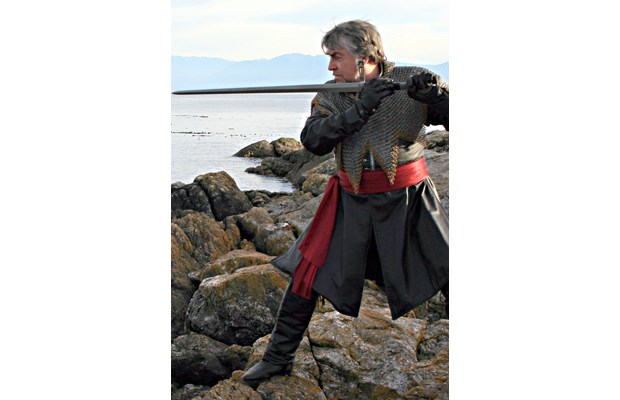F. Braun McAsh admits he has wanted to throw things at the screen while watching movies that fail to depict combat sequences with historical authenticity.
The veteran actor, swordmaster and fight director alludes to the classic "cricket bat" monologue in Tom Stoppard's The Real Thing. Henry, a young playwright, says "It's better because it's better," comparing the virtues of a meticulously crafted cricket bat to the inferiority of a lump of wood that seems similar but is vastly inferior.
"A lot of people get their sense of history from movies, not from books, and they've been shown the wrong way so many times, they assume it's the right way," McAsh says with a sigh. "Why not do it right?"
Getting it right has been the Vancouver-based weapons expert's chief motivation over a 36-year film and theatre career, which has included work on the stages of Stratford and as a professional fight director for stage, film and television, notably the Highlander TV series.
"You get the idea from bad movies [that] people go out and hack and slash each other and die from sheer exhaustion," says McAsh, who will share his expertise in an all-day workshop Saturday in Mill Bay, covering the basics of the German school of the two-handed longsword, a weapon that will be familiar to viewers of movies such as Lord of the Rings and Kingdom of Heaven.
Another Hollywood misconception he passionately dispels is that martial arts is strictly the domain of Asian combatants.
"We've been culturally inculcated into thinking that," he said. "Martial arts is a fighting art. The European arts are just as old and have as much validity. The irony is we've been ignoring our own martial-arts heritage, almost to the point [that it has] disappeared."
A meticulous researcher, McAsh has extensive knowledge of armour, military history and authentic and theatrical techniques with weaponry from eras including the Renaissance (rapiers, daggers, sideswords) and Restoration (military sabre, Scottish basket-hilt Claymore). The former military NCO is also experienced with handguns, submachine guns, assault rifles and bayonets, and is an expert in Japanese, Korean, Filipino and Chinese martial arts with two black belts.
His unarmed-combat skills include taekwondo, aikido, judo, shotokan and gojo-ryu karate and Iaido.
"Professional violence," as he terms it, is a calling McAsh takes seriously - from selecting suitable weapons to staging.
"If you use authentically historical moves, it's safe," he says, noting there's no "generalized system," since bladed weapons are handled in different ways. "You're not trying to force a weapon to do something it's not designed to do. You cannot make a rapier behave like a two-handled broadsword."
His goal is to authentically interpret the purpose and story of the fight - "a venue that can bring out aspects of the character the script suggests."
Exceptions to the authenticity rule that he can tolerate include The Princess Bride. "It's a romp. They're talking about real Italian fencing masters of the Renaissance, but it's an homage to the Errol Flynn era of swashbuckling. When you watch Errol Flynn movies, you're not seeing historical authenticity."
A competitive fencer who studied stage combat at the Royal Academy in England, McAsh apprenticed with Flynn's principal stunt double at Stratford - fight master Paddy Crean.
He also got to perform there with Maggie Smith in A Midsummer Night's Dream and worked with Peter Ustinov on King Lear.
"He was the [ultimate] raconteur," McAsh recalled. "And Maggie was one of the most generous and giving actors. These people are just actors who have evolved far beyond egotism. It's not about them. It's about the play."
He said a fight director's ideal skillset includes "having the guts to say no to a director, and to tell him why."
A weapon might not be safe for use in a certain environment, for instance, or insufficient time for training could be an issue.
"The director's the captain of the ship. You might take the wheel here and there, but he calls the shots."
When McAsh joined Highlander in its third season, the fighting style of Duncan MacLeod, the immortal played by Adrian Paul, began to change with his use of the Katana, a Japanese sword.
"It's an elegantly simple weapon," explains McAsh, who incorporated classical Japanese and Korean techniques. "[The character is] over 400 years old, so he trained with many different swords," said the fight master, who tries to use as many different weapons and original moves as possible.
McAsh, whose onscreen appearances include his Dream Warrior in the Shadows episode, fulfilled that goal in Highlander 4: End Game, when he had Duncan use a predominantly Chinese style to battle his brother Connor, who used a Katana.
"What hacks me is when I see a fight scene and both men are wearing the same weapons, like swords or rapiers," he said. "I'm thinking, 'Two guys from different areas are trained by different masters, so why are your styles identical?' "
He was elated that Highlander fans noticed Duncan was suddenly using moves previously used by Connor, who inhabits him.
Fight choreography is "illusionary violence," said McAsh, who knows he's succeeded if viewers simply accept it.
"It's like when you see Baryshnikov dancing in a ballet. You don't see the decades he's studied to pull those moves off."
To register for F. Braun McAsh's Saturday workshop - which runs from 9 a.m. to 5 p.m. at Traditional Martial Arts Academy, 2746 Barry Rd. in Mill Bay - visit theringofsteel.com. The cost is $125 plus HST.



